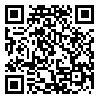Volume 22, Issue 1 (4-2023)
TB 2023, 22(1): 47-60 |
Back to browse issues page
Ethics code: IR.USWR.REC.1399.164
Download citation:
BibTeX | RIS | EndNote | Medlars | ProCite | Reference Manager | RefWorks
Send citation to:



BibTeX | RIS | EndNote | Medlars | ProCite | Reference Manager | RefWorks
Send citation to:
Ekrami A, hosseini M A, Ekrami H. Comparative Evaluation of the level of contamination of internal hospital surfaces, using two methods: nano biosensor and microbial culture. TB 2023; 22 (1) :47-60
URL: http://tbj.ssu.ac.ir/article-1-3452-en.html
URL: http://tbj.ssu.ac.ir/article-1-3452-en.html
USWR , mahmaimy2020@gmail.com
Abstract: (870 Views)
Background: Today, out of every 5% to 10% of patients admitted to the hospital, one patient is involved in the complications of hospital infections, which has been confirmed to be directly related to the spread of these infections with the contamination of hospital surfaces. Therefore, it is very important to use an efficient method to identify microbial contamination. To this end, this study was carried out to compare the level of contamination of indoor hospital surfaces using two methods of dye detector nanosensor and microbial culture medium (traditional method).
Method: The present descriptive study was carried out with a sample size of 400 cases on ten types of medical equipment for three months using dye detector nanosensor and microbial culture medium. The results were reported as clean and contaminated.
Results: According to the results, 44% of the samples of microbial culture medium and 45.5% of nanosensor samples were reported positive (contaminated). The samples obtained from static microbial culture, ventilator, and the samples obtained from nanosensor, static, and pulse oximetry were identified as the most contaminated surfaces. Also, E. coli (55.68%), Staphylococcus aureus (28.9%), and Salmonella (23.86%) were recognized as the most common microorganisms.
Conclusion: The amount of contamination detected by both methods is acceptable due to the high sensitivity of both methods and lack of sterile surfaces. Therefore, in cases where only the detection of general contamination is considered, not isolation of bacteria, dye detector nanosensors can be used as a rapid method to control the contamination of surfaces instead of traditional methods.
Method: The present descriptive study was carried out with a sample size of 400 cases on ten types of medical equipment for three months using dye detector nanosensor and microbial culture medium. The results were reported as clean and contaminated.
Results: According to the results, 44% of the samples of microbial culture medium and 45.5% of nanosensor samples were reported positive (contaminated). The samples obtained from static microbial culture, ventilator, and the samples obtained from nanosensor, static, and pulse oximetry were identified as the most contaminated surfaces. Also, E. coli (55.68%), Staphylococcus aureus (28.9%), and Salmonella (23.86%) were recognized as the most common microorganisms.
Conclusion: The amount of contamination detected by both methods is acceptable due to the high sensitivity of both methods and lack of sterile surfaces. Therefore, in cases where only the detection of general contamination is considered, not isolation of bacteria, dye detector nanosensors can be used as a rapid method to control the contamination of surfaces instead of traditional methods.
Keywords: Infection Control, Nanotechnology, Contamination Control Indicators, Healthcare-Associated Infections, Dye Detector Nanosensor
Type of Study: Research |
Subject:
Special
Received: 2022/10/19 | Accepted: 2023/03/5 | Published: 2023/04/30
Received: 2022/10/19 | Accepted: 2023/03/5 | Published: 2023/04/30
Send email to the article author
| Rights and permissions | |
 |
This work is licensed under a Creative Commons Attribution-NonCommercial 4.0 International License. |







